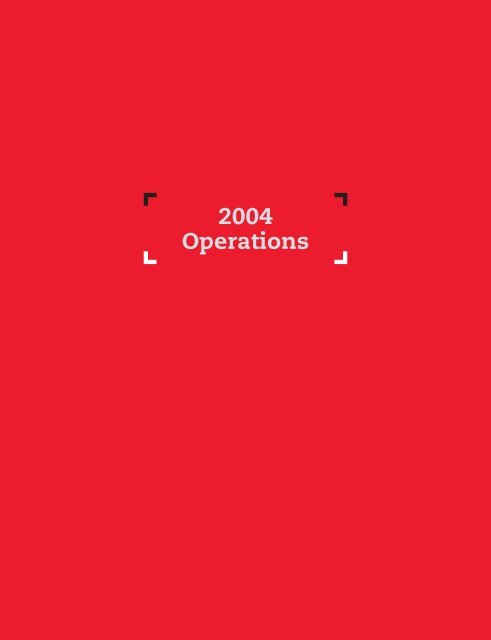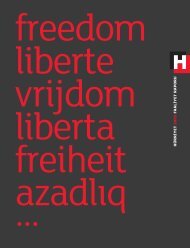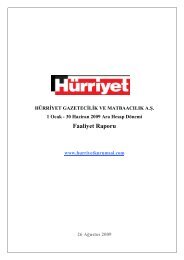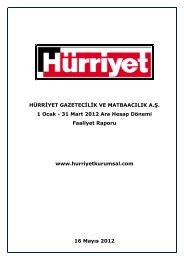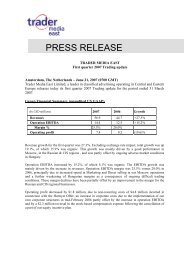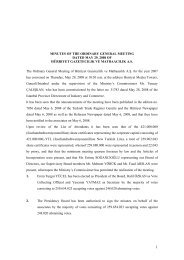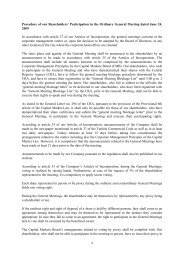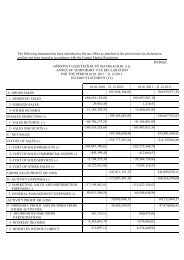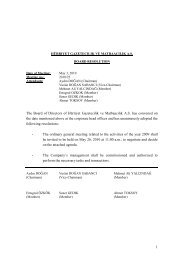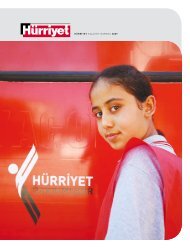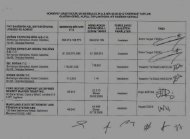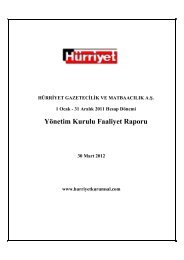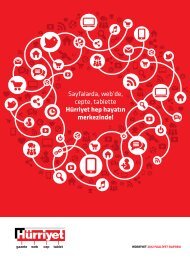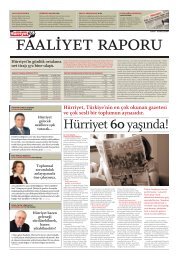2004 Operations
HURRIYET 04 FR ing.fh9
HURRIYET 04 FR ing.fh9
You also want an ePaper? Increase the reach of your titles
YUMPU automatically turns print PDFs into web optimized ePapers that Google loves.
<strong>2004</strong><br />
<strong>Operations</strong>
HÜRR‹YET<br />
ANNUAL REPORT <strong>2004</strong><br />
Page 34<br />
<strong>2004</strong> <strong>Operations</strong><br />
Hürriyet has combined the effects of rapid economic growth<br />
in <strong>2004</strong> with successful management resulting in an increase<br />
of its advertising market share. Overall, Hürriyet’s total<br />
advertising revenue has grown by 47% in <strong>2004</strong>.<br />
Hürriyet: The leader of the media sector in <strong>2004</strong><br />
Turkey’s rapid economic growth in <strong>2004</strong><br />
was reflected in consumer spending thereby<br />
increasing advertising budgets. At the end of the<br />
year, total advertising market had reached<br />
approximately US$ 1,237 million, a 37% increase<br />
over that of the previous year. While the advertising<br />
market share for television commercials reached<br />
51%, the share of newspaper advertising has<br />
increased by 1%, to 36%. Nonetheless, over the past<br />
year, the newspaper advertising market has risen<br />
from US$ 312 million to US$ 443 million.<br />
Provided that economic growth continues,<br />
it is expected that total advertising spending in 2005<br />
will reach US$ 1.5 billion.<br />
Hürriyet, which benefited from the effects<br />
of rapid growth through successful management,<br />
increased its advertising market share. Overall,<br />
Hürriyet increased its total advertising revenue by<br />
47% in <strong>2004</strong>.<br />
2003-<strong>2004</strong> Total Advertising Revenue<br />
(US$ million)<br />
901<br />
1,237<br />
448<br />
1.400<br />
1.200<br />
1.000<br />
800<br />
600<br />
400<br />
200<br />
TOTAL<br />
TV<br />
NEWSPAPER<br />
MAGAZINE<br />
RADIO<br />
OUTDOOR<br />
MOVIES<br />
INTERNET<br />
36<br />
46<br />
40<br />
46<br />
47<br />
53<br />
11<br />
16<br />
7<br />
7<br />
626<br />
312<br />
443
To communicate to the<br />
advertising world that<br />
newspapers are the<br />
best means of<br />
advertising, Hürriyet<br />
organized the second<br />
“Red Awards.”<br />
Advertising revenue as a source for investments<br />
The increase in advertising spending in<br />
<strong>2004</strong> primarily came from the automotive industry,<br />
textile, construction, communication, information<br />
technology and beverage sectors. Hürriyet kept its<br />
number one position in human resources advertising<br />
and classified ads.<br />
Hürriyet’s Advertising Revenue<br />
2003-<strong>2004</strong><br />
(US$ million)<br />
125<br />
2003<br />
183<br />
<strong>2004</strong><br />
210<br />
200<br />
190<br />
180<br />
170<br />
160<br />
150<br />
140<br />
130<br />
120<br />
110<br />
Maintaining its market share of advertising<br />
revenue and raising the advertising unit price are<br />
among Hürriyet’s business targets for the coming<br />
years. To accomplish this, Hürriyet will develop<br />
specific projects aimed at increasing newspaper<br />
advertising.<br />
Additionally, Hürriyet plans to monitor the<br />
choice of venue made by advertisers, to inform the<br />
sales team of its findings and develop projects<br />
regarding sales strategies accordingly.<br />
Hürriyet’s advertising market share is 41.3%<br />
As has been the case in the past, Hürriyet<br />
was the media organization with the largest<br />
advertising market share in <strong>2004</strong>. Hürriyet’s share<br />
in the total advertising market has risen to<br />
14.8% - an increase of 0.9 points. Its share in the<br />
newspaper advertising market rose to 41.3% - an<br />
increase of 1.1 points.<br />
Hürriyet Advertising Market Share<br />
Hürriyet’s share in the total market<br />
Hürriyet’s share in the newspaper<br />
advertising market<br />
50<br />
In <strong>2004</strong>, Hürriyet’s total revenue from<br />
special projects amounted to US$ 6,461,767. Of this<br />
amount, US$ 1,513,206 came from 28 private-label<br />
newspapers (18 company-specific newspapers and<br />
10 industry-specific newspapers) and the balance<br />
is from sponsorship and special projects.<br />
To communicate to the advertising world<br />
that newspapers are the best means of advertising,<br />
Hürriyet organized the second “Red Awards.” As the<br />
first and only contest involving press advertisements<br />
in Turkey, “Red” has had the continuing support of<br />
the entire sector in its second year as a total of 830<br />
press advertisements from 85 advertising agencies<br />
entered the contest.<br />
40.2<br />
13.9 14.8<br />
2003<br />
<strong>2004</strong><br />
41.3<br />
40<br />
30<br />
20<br />
10
HÜRR‹YET<br />
ANNUAL REPORT <strong>2004</strong><br />
Page 36<br />
<strong>2004</strong> <strong>Operations</strong><br />
Despite limitations imposed on newspapers’ marketing<br />
and promotional activities by legal regulations<br />
passed in mid-2003, Hürriyet reached a circulation of<br />
495,000 - an increase of 7.60%.<br />
Sales as a competitive advantage<br />
According to the data gathered by the Press<br />
Advertising Organization, the average net sales of<br />
daily newspapers all over the country has increased<br />
by 8.56% and totaled 4,682,195 in <strong>2004</strong>; this figures<br />
previously stood at 4,313,045 in 2003. The reasons<br />
for this increase include the diminishing effect of<br />
Turkey’s 2001 economic crisis, the fact that<br />
segmentation among newspapers has become fully<br />
visible and low-price newspaper options were<br />
available to readers.<br />
Average Daily Circulation of<br />
Newspapers<br />
(units)<br />
4,313,045<br />
2003<br />
4,682,195<br />
Hürriyet aims to retain its reader profile<br />
along and to maintain its leading position in the<br />
market, therefore, it maintains its price level and<br />
does not employ a competitive pricing policy to<br />
raise its circulation. Despite the limitations brought<br />
upon the marketing and promotional activities of<br />
newspapers by the legal regulations passed in mid-<br />
2003, Hürriyet achieved a circulation of 495,000 -<br />
an increase of 7.6% to reach a market share of 10.9%.<br />
During <strong>2004</strong>, Hürriyet did not increase the<br />
price of weekday editions due in large part to the<br />
decrease in the inflation rates and the stabilization of<br />
<strong>2004</strong><br />
4,900,000<br />
4,800,000<br />
4,700,000<br />
4,600,000<br />
4,500,000<br />
4,400,000<br />
4,300,000<br />
4,200,000<br />
4,100,000<br />
Comparison of Hürriyet’s Circulation<br />
(in thousand units) 500<br />
495<br />
480<br />
460<br />
2003<br />
460<br />
440<br />
420<br />
the economy. On August 22, <strong>2004</strong>, Hürriyet raised the<br />
price for its Sunday edition -from YKR 35 to YKR 40.<br />
Hürriyet now reaches its readers through<br />
23,400 sales points in 81 cities, districts and other<br />
residential areas throughout the country. Of this<br />
total, 66.3% takes place in Turkey’s three largest<br />
cities; Istanbul, Ankara and Izmir. In comparison<br />
to its weekday circulation, sales of Hürriyet go up<br />
by 80,000 on Saturdays and 260,000 on Sundays.<br />
Hürriyet’s goal is to maintain its status as<br />
the best-selling newspaper and will continue to be<br />
the daily with the highest value. The following<br />
measures will be taken to ensure the<br />
accomplishment of this goal:<br />
• Maintain the continuity of a profitable selling price<br />
• Implement the practice of a special weekend price<br />
• Put out new supplements that increase sales<br />
turnover without creating loss<br />
• Undertake product differentiation to contribute<br />
to an increase in the turnover<br />
• Increase interaction with the reader so as to<br />
develop a more comprehensive database.<br />
<strong>2004</strong>
In the belief that it is<br />
indispensable that the<br />
publishing business to<br />
embrace life in all of<br />
its dimensions,<br />
Hürriyet prepares<br />
supplements and<br />
regional newspapers<br />
that add value to the<br />
lives of its readers and<br />
provide new<br />
opportunities for<br />
advertisers.<br />
Supplements addressing a diverse audience<br />
In the belief that it is indispensable that<br />
the publishing business to embrace life in all of its<br />
dimensions, Hürriyet prepares supplements and<br />
regional newspapers that add value to the lives of<br />
its readers and provide new opportunities for<br />
advertisers.<br />
Kelebek was re-published in <strong>2004</strong> and is<br />
one of Hürriyet’s most important trademark<br />
supplements. With its emergence into the market<br />
in March of <strong>2004</strong>, Kelebek filled a gap and has made<br />
a significant contribution to Hürriyet’s circulation<br />
(approximately 35,000 additional sales).<br />
These supplements are important factors<br />
that distinguish Hürriyet in the Turkish media.<br />
Hürriyet’s supplement ‹K has reinforced Hürriyet’s<br />
leadership in the field of human resources; it not<br />
only addresses professionals seeking to expand in<br />
their lives, but it also impacts institutions. It has<br />
also succeeded in becoming an important advertising<br />
medium.<br />
Putting an emphasis on rich content,<br />
Hürriyet Sunday has been developed to maintain<br />
the Newspaper’s leading position in the sector. The<br />
importance of its role is evident from the fact that<br />
based on Sunday sales, Hürriyet is by far the bestselling<br />
newspaper in Turkey.<br />
Utilizing this approach, in <strong>2004</strong> Hürriyet<br />
continued to release supplements addressing the<br />
needs and interests of diverse groups. Among them,<br />
the Travel supplement aims to become a domestic<br />
and international travel/culture guide for its readers,<br />
as well as an effective advertising vehicle for the<br />
tourism sector. Ever since its first issue was<br />
published, Travel has been well-received by Hürriyet<br />
readers, reaching an audience of 1,032,000 each<br />
week.<br />
Gaining momentum in the automotive<br />
industry, Hürriyet released its Auto Life supplement<br />
in 2003, thus targeting an emerging advertising<br />
potential. With a look at the world of automobiles<br />
from both male and female perspectives, Auto Life’s<br />
vivid content includes everything from novelties in<br />
the automotive industry to motor sports and<br />
commercial vehicles to financial services. Every<br />
week Auto Life reaches 1,212,000 readers.<br />
The share of regular weekly supplements<br />
in the total advertising revenue has risen to 21.2%<br />
in <strong>2004</strong>, up from 19.7% the previous year.<br />
By publishing supplements that increase<br />
turnover without incurring loss, Hürriyet will<br />
continue to offer its readers new choices as it grows<br />
in value.
HÜRR‹YET<br />
ANNUAL REPORT <strong>2004</strong><br />
Page 38<br />
<strong>2004</strong> <strong>Operations</strong><br />
In its effort to increase the quality of production through<br />
modernization, Hürriyet has continued making investments<br />
at the same pace as in previous years. It continues to obtain<br />
investment incentive certificates for future investments.<br />
Investments shaping the vision for the future<br />
Hürriyet has accomplished a significant<br />
portion of its investments. Ongoing projects aim at<br />
increasing productivity. Through investments made<br />
in template-typesetting, automatic stapling and folding<br />
systems, the printing facilities in Istanbul were fully<br />
equipped in 2003. At the same time, film preparation<br />
machines were purchased due to the increase in the<br />
number of published newspaper pages.<br />
These investments have enabled Hürriyet to<br />
achieve faster and more modern mass production as<br />
well as to respond appropriately to its advertisers’<br />
colored ad requirements. Newly acquired machinery<br />
was installed at the Esenyurt Printing Facilities, a<br />
project that began in 1999 and was completed in 2000.<br />
In the two years that followed, Hürriyet began<br />
production with its two Man Colorman printing presses,<br />
equipment manufactured with the latest technology<br />
for use by high-circulation newspapers. These<br />
machines have the capability to print a total of sixtyfour<br />
pages, forty of which can be printed in color. With<br />
the folding apparatus attached, it is possible to print<br />
two different newspapers simultaneously, each with<br />
a total of sixty-four pages.<br />
In an effort to increase the quality of<br />
production through modernization, Hürriyet continued<br />
making investments at the same pace as in previous<br />
years. It continues to obtain investment incentive<br />
certificates for future investments. A total of US$<br />
19,188,893 in <strong>2004</strong> has been invested in the printing<br />
facilities primarily in Adana, Istanbul, Ankara, Izmir<br />
and Antalya. The investment incentive certificates<br />
obtained in 2002 and in September <strong>2004</strong> were used to<br />
import machines totaling US$ 10,653,005.<br />
Investments in the Last Eight Years (1997 - <strong>2004</strong>)<br />
(US$ million)<br />
126.7 Machinery<br />
11.9 Other<br />
Total 226.0<br />
48.2 Land<br />
38.9 Building
The DPCs, which<br />
create operational<br />
synergy among Do¤an<br />
Yay›n Holding<br />
newspapers, also play<br />
an important role in<br />
cutting expenses<br />
through their ability<br />
to actualize large<br />
paper purchases and<br />
provide storage for all<br />
the Group’s<br />
newspapers.<br />
Printing Centers Capacity Utilization Ratio (%)<br />
DPC- ISTANBUL 86<br />
DPC-ANKARA 84<br />
DPC-IZMIR 90<br />
DPC-TRABZON 62<br />
DPC-ANTALYA 58<br />
DPC-ADANA 93<br />
DPC-FRANKFURT 65<br />
Printing as a part of Total Quality Management<br />
The DPCs, which create operational synergy<br />
between Do¤an Yay›n Holding newspapers, also<br />
play an important role in cutting expenses through<br />
their ability to actualize large paper purchases and<br />
provide storage for all the Group’s newspapers.<br />
Hürriyet is printed by facilities operating<br />
under the umbrella of the Do¤an Printing Center<br />
(DPC). In Turkey, printing is done in Istanbul, Ankara,<br />
Izmir, Antalya, Adana and Trabzon and in Germany<br />
in the Frankfurt facility. Do¤an Yay›n Holding, with<br />
its growing printing capability, combined the<br />
separate printing centers of Hürriyet and Milliyet<br />
in order to attain maximum efficiency and low-cost<br />
production and printing. In 1996, the printing<br />
facilities of the newspapers Hürriyet and Milliyet<br />
in Trabzon were combined and renamed Do¤an<br />
Printing Center. The same process was repeated in<br />
Ankara, Izmir, Antalya, Adana and finally in<br />
Istanbul, thus joining all printing operations under<br />
the DPC umbrella.<br />
In addition to Hürriyet and its supplements,<br />
these printing facilities provide services to other<br />
companies both within the Group and outside. They,<br />
therefore, contribute to the turnover and profitability<br />
of the Company. In <strong>2004</strong>, the DPCs’ total revenue<br />
amounted to YTL 102.2 million.<br />
The calculations are made on the basis of<br />
a 16-hour per day printing capacity for the printing<br />
presses.<br />
The DPCs provide innovative leadership in<br />
Turkey with regard to their stable growth and<br />
flexible, high-quality and productive work principles.<br />
They use 240,000 tons of paper annually and are<br />
among the most renowned facilities in the<br />
international newspaper industry.
HÜRR‹YET<br />
ANNUAL REPORT <strong>2004</strong><br />
Page 40<br />
<strong>2004</strong> <strong>Operations</strong><br />
The Istanbul DPC, with its 17,000-m 2 enclosed area,<br />
is the largest in Turkey in terms of capacity and is ranked<br />
second largest in Europe.<br />
The most important reason for the 26% rise in DPC revenue in the last year was the increase in the<br />
circulation and number of pages of Hürriyet and the other newspapers owned by the Group. This is also a<br />
major factor for the rise in DPC revenue now making up an approximate 22% share in Hürriyet’s total revenue.<br />
Production Category <strong>2004</strong> Total number of pages 2003 Total Number of Pages Increase %<br />
Main Newspaper 17,332,157,094 11,950,853,825 45.03<br />
Contracted Jobs 22,396,593,956 19,577,617,508 14.4<br />
TOTAL 39,728,751,050 31,528,471,333 26.0<br />
The Istanbul DPC, with its 17,000-m2<br />
enclosed area, is the largest in Turkey in terms of<br />
capacity; it is ranked the second largest in Europe.<br />
The facility features two Man Colorman printing<br />
presses, possessing the capacity to print 85,000<br />
copies per hour, each totaling sixty-four pages,<br />
including forty in color. The Istanbul DPC also has<br />
three Goss HT-70 printing presses. The Man printing<br />
presses are also linked to the Müller Martini “insert”<br />
system, a novel technological development allowing<br />
for the insertion of up to six inserts or supplements<br />
during or after the printing process.<br />
The facility is also furnished with the<br />
Computer-to-Plate (CTP) system, an innovative<br />
technological method that allows for the direct<br />
plating of the pages received from the editors and<br />
marking the first time this system was used in<br />
Turkey. This facility is equipped to handle the<br />
flawless, automatic plating of 4,800 templates per<br />
day, making the Istanbul DPC number one in the<br />
world in terms of the number of CTP templates<br />
produced at a single location.<br />
Also at the Istanbul DPC, printed paper or<br />
commercial inserts can be placed in newspaper<br />
copies during or after printing by the available insert<br />
system. Up to six inserts can be simultaneously<br />
placed into copies. A total of 200 tons of printed<br />
matter can be stored on the facility’s 350 rolls.<br />
Due to the modernization of the Company’s<br />
printing centers, waste was a minimal average of<br />
5.22% in <strong>2004</strong>.<br />
Investments as required by market<br />
conditions and competition will also continue in<br />
future years.
With an average daily<br />
circulation of 130,000-<br />
140,000, Hürriyet is<br />
both the best-selling<br />
Turkish newspaper in<br />
Europe and one of the<br />
best-selling foreign<br />
daily newspapers on<br />
the continent.<br />
Access beyond borders: <strong>Operations</strong> in Europe<br />
As Turkey’s only paper with global access,<br />
Hürriyet operates in Europe through its office in<br />
Mörfelden Walldorf, a town near Frankfurt, Germany<br />
and its huge printing facility there, a branch of the<br />
DPC. Hürriyet, meeting the need for news and<br />
comments of Turkish people living in Western<br />
Europe, is also an important source of news for<br />
regional events, owing to its strong network of<br />
reporters in these countries.<br />
With an average daily circulation of 130,000-<br />
140,000, Hürriyet is both the best-selling Turkish<br />
newspaper in Europe as well as the one of the bestselling<br />
foreign daily newspapers on the continent.<br />
Hürriyet’s availability abroad is not limited<br />
to countries in Western Europe. In addition to its<br />
distribution from 20,000 sales locations in Germany,<br />
Hürriyet reaches another 24 countries at 30,000<br />
locations across Europe through the Axel-Springer<br />
distribution network. Today, Hürriyet is read<br />
throughout the continent, all the way from England<br />
to Romania and from the countries of Scandinavia<br />
to Italy; it also reaches as far as Canada.<br />
The Hürriyet-USA daily which had been<br />
printed in Germany and sent to USA has been<br />
printed in New York as of November 1, <strong>2004</strong>. At the<br />
same time, it is also published daily in several other<br />
states other than New York.<br />
Hürriyet manages its operations abroad<br />
under the umbrella of DMG International, which<br />
was founded in 1999 to function as Do¤an Yay›n<br />
Holding’s gateway to Europe. The Company oversees<br />
most of DYH’s publications and broadcasting<br />
targeting Turkish people living in Europe. It also<br />
plays an important role in enhancing DYH’s<br />
relationship and communication with Europe’s<br />
leading media companies. With an average daily<br />
circulation of 165,000 across Europe via Hürriyet,<br />
Milliyet and Fanatik, DMG International raises the<br />
banner for DYH as a market leader on the continent.<br />
In addition to DMG International<br />
publications, the printing facilities produce the<br />
Germany edition of the international finance<br />
newspaper, The Wall Street Journal Europe, the<br />
American newspaper Stars&Stripes and Sportwelt,<br />
the German sports paper. With these foreign<br />
publications, the total number of newspapers<br />
produced at the printing facilities amount to<br />
215-235 thousand units.<br />
The advertising revenue of Hürriyet Europe<br />
newspaper totaled 6.6 million in 2003 and 6.5<br />
million in <strong>2004</strong>.
HÜRR‹YET<br />
ANNUAL REPORT <strong>2004</strong><br />
Page 42<br />
<strong>2004</strong> <strong>Operations</strong><br />
With its rich filling content, an average of almost two million<br />
monthly visitors and 90 million hits, Hürriyetim is the<br />
leading Internet publication in Turkey and among the<br />
foremost in Europe.<br />
Internet services with a global approach<br />
Among Hürriyet’s major business aims is<br />
to maintain its leading status not only in the printed<br />
press but in the Internet news sector as well. For<br />
this reason the Hürriyet online was founded on<br />
January 1, 1997. Following the adoption of the name<br />
Hürriyetim in December 1999, Hürriyet became one<br />
of the first newspapers to be Internet accessible. In<br />
October 2000, hurriyetim.com.tr shed its status as<br />
merely the Internet version of the Hürriyet<br />
newspaper and began serving as a 24-hour news<br />
portal reporting the day’s events around the clock.<br />
Formerly operating as a division of Hürriyet<br />
Gazetecilik ve Matbaac›l›k A.fi., Hürriyetim became<br />
a Hürriyet affiliated company called Hürriyet<br />
Internet Hizmetleri ve Ticaret A.fi. on January 1,<br />
2001.<br />
With its rich content, an average of nearly<br />
two million monthly visitors and 90 million hits,<br />
Hürriyetim is the leading Internet publication in<br />
Turkey and among the foremost in Europe. In <strong>2004</strong>,<br />
Hürriyetim overall revenue accrued from content<br />
services to companies outside the Group, from<br />
banner sales and from special projects such as the<br />
Green Card and Mobile Hürriyetim totaled YTL<br />
1,355,910.<br />
In 2005, Hürriyetim plans to develop and<br />
implement new and creative approaches, including<br />
making the website more user-friendly by renewing<br />
the content management infrastructure and<br />
developing interactive tools for it.<br />
Human resources subject to performance analysis<br />
As a result of the Search Conferences<br />
organized at the beginning of 2003, the Company<br />
established the Human Resources Committee, for<br />
the purpose of development and restructuring. In<br />
executing the project, the team, comprised of<br />
employees from the Media Group, Treasury,<br />
Information Systems, Advertising, Payroll and<br />
Human Resources, inspected all aspects of<br />
operations in the human resources processes,<br />
determined shortcomings, generated creative<br />
solutions and began the implementation process.<br />
This took place in twelve meetings that lasted a<br />
total of 35 hours. In this context, the team updated<br />
Job Descriptions and Organizational Charts, created<br />
a new Performance Evaluation System, assessed<br />
and renovated the Search and Recruitment Processes<br />
and evaluated the Training Management.<br />
The Search Conference also was<br />
instrumental in the formation of the<br />
Communications Committee and to implement<br />
necessary improvements in the human resources<br />
processes. The basis of this human resources<br />
enhancement project included dealing with such<br />
issues as the lack of information-sharing within the<br />
Company, the lack of communication, the<br />
insufficient appreciation of employees and the lack<br />
of a fair system of wages.<br />
In the update of job descriptions phase,<br />
Division heads had meetings with all groups in order<br />
to ensure the greatest possible employee<br />
participation. These meetings, lasting a total of 130<br />
hours, resulted in the renewal of the format of job<br />
descriptions, including the rectification of its<br />
shortcomings and bringing the system into full<br />
compliance with all amendments in the labor laws<br />
in 2003. Thus, the renewed job descriptions now<br />
fully address the requirements of both business<br />
demands and performance criteria for all employees.
Established to facilitate success and create<br />
high-quality human resources with high<br />
performance, the Performance Evaluation System<br />
is expected to measure Performance Highlights and<br />
Competencies, including individual, functional and<br />
administrative competencies. This system will allow<br />
individual employees to evaluate themselves, as<br />
well as assessment by their supervisors and<br />
colleagues. The biannual performance evaluation<br />
system forms the basis of the Wage Management<br />
and Rewards System, Career Planning and Training<br />
Management.<br />
The overall goal is to establish competitive<br />
and egalitarian recruitment and an employment<br />
system that produces quality work with the<br />
appropriate human resources. Toward this end, a<br />
new electronic system called the Question Bank has<br />
been set up to support Recruitment Management.<br />
This system will be extended to the entire Company;<br />
it aims to fairly and accurately evaluate the general<br />
cultural and professional knowledge of the<br />
applicants by means of an exam given prior to the<br />
initial interview for each position.<br />
Comprehensive training sessions were<br />
organized in <strong>2004</strong>, primarily for the Media Group.<br />
Plans for training all groups are in place for 2005.<br />
In <strong>2004</strong>, the systems designed in 2003 as<br />
parts of the enhancement program for Human<br />
Resources started to be implemented. These systems<br />
include recruitment and employment, performance<br />
evaluation, fair wages and training systems. The<br />
designing phase of performance evaluation system<br />
was completed in April, <strong>2004</strong> and tested in some<br />
pilot divisions during May <strong>2004</strong> and implemented<br />
throughout the corporation in December <strong>2004</strong>. In<br />
January 2005, the results of the performance<br />
evaluation system for the first time were reflected<br />
in an increase in wages.<br />
The performance evaluation system<br />
developed by Do¤an Yay›n Holding for all of its<br />
subsidiaries is based on Hürriyet’s performance<br />
evaluation system. Two officers from Hürriyet’s<br />
Human Resources Department joined the project<br />
team organized within the scope of this study. With<br />
the new system constituted throughout entire Do¤an<br />
Yay›n Holding, all terms of reference and<br />
organizational structure are redefined in the<br />
Holding-wide deployed personnel system.<br />
The test bank system, completed in 2003,<br />
was initially used for the selection of Economy<br />
Correspondence and then for the Intelligence<br />
Correspondence positions, producing very successful<br />
results. Of the employees hired utilizing this test<br />
bank, 90% are still continuing to work at the<br />
Holding’s enterprises.<br />
Together with an HR consultation company,<br />
an efficiency and workload study has been initiated.<br />
The service contracts of the employees at all<br />
establishments affiliated with Hürriyet’s Human<br />
Resources Department are renewed pursuant to the<br />
amended labor law.<br />
The terms of reference and organizational<br />
structure of other establishments affiliated to<br />
Hürriyet’s Human Resources Department have been<br />
updated.<br />
Company-wide human resources reporting<br />
standards have been restructured at Hürriyet; the<br />
initial implementation was carried out in January<br />
2005. These standards will be implemented at all<br />
related establishments within a planned period.
HÜRR‹YET<br />
ANNUAL REPORT <strong>2004</strong><br />
Page 44<br />
<strong>2004</strong> <strong>Operations</strong><br />
On September 18, 2005, Hürriyet started a campaign in<br />
collaboration with Contemporary Education Foundation (Ça¤dafl<br />
E¤itim Vakf›) and the Governorship of Istanbul, to prevent<br />
domestic violence. The campaign “Stop Domestic Violence!”<br />
also won an award in the category of Social Responsibility<br />
Project in the <strong>2004</strong> Creativity Awards organized by DYH.<br />
Comprehensive projects of social responsibility<br />
As an integral part of its role in Turkey’s<br />
modernization process, Hürriyet believes it should<br />
do its part in attending to social problems. Hürriyet’s<br />
illustrious history is replete with examples of<br />
campaigns that support this position. In 1983, a fund<br />
raising campaign was conducted to help the families<br />
of the 96 people who died in the mine explosion at<br />
Kozlu, Zonguldak. Likewise, the “You Add a Brick,<br />
too” campaign was organized to help heal the<br />
devastation of the August 17, 1999 earthquake, the<br />
largest aid operation ever organized in Turkey.<br />
“Stop Domestic Violence!” campaign<br />
Globally, one out of four females and one<br />
male out of six will become a victim of domestic<br />
violence at some time in their life. According to the<br />
data collected by the government’s Family Studies<br />
Organization in Turkey, physical violence is seen in<br />
one family out of three while verbal abuse occurs in<br />
one out of two families. Women and children are the<br />
most frequent victims of serious and violent abuse.<br />
Hürriyet sees domestic violence as a fundamental<br />
social problem that can neither be tolerated nor accepted<br />
as an ordinary phenomenon. The harm it does to family<br />
members is impossible to erase without years of<br />
intervention. Aside from this, the goal of the “Stop<br />
Domestic Violence!” campaign is to uncover the source<br />
of domestic violence throughout the family, especially<br />
with regard to women and children, to contribute to<br />
establishment of non-violent families and to invite all<br />
the social groups to say “Stop Domestic Violence!”<br />
On October 18, <strong>2004</strong>, the first meeting of the<br />
“Stop Domestic Violence!” campaign was held in the<br />
Çetin Emeç Hall at Hürriyet Media Towers. Hürriyet’s<br />
Chief Executive Officer Vuslat Do¤an Sabanc› and<br />
Editor-in-Chief Ertu¤rul Özkök discussed Hürriyet’s<br />
reason for targeting this situation which constitutes<br />
a serious social problem in Turkey.<br />
The campaign was created to take a public<br />
stance against domestic violence - a crucial problem<br />
the world over - and to initiate social transformation<br />
from such a position.<br />
Mobile Classrooms offer Training Sessions in Istanbul<br />
Within the scope of this campaign, Hürriyet<br />
organized an Assistance Program to help improve<br />
communication within families in collaboration with<br />
Contemporary Education Foundation and the<br />
Governorship of Istanbul. During the first stage,<br />
training sessions for participants, male and female,<br />
were provided in a specially redesigned bus that<br />
served as a mobile classroom in Gaziosmanpafla,<br />
Ümraniye, Ka¤›thane and Bak›rköy districts. These<br />
sessions covered a whole array of topics;<br />
comprehensive description of domestic violence, the<br />
influences of violence on family members, the<br />
differences between men and women with respect<br />
to domestic violence, alternative problem-solving<br />
methods without resorting to violence, the concept<br />
of the good and powerful husband/father, anger<br />
control, the Family Protection Law and ways of coping<br />
with violence. At the end of training session, each<br />
participant was given special buttons, a method<br />
enabling the participants to help convey such<br />
information to others and attract more visitors to<br />
the mobile classroom.<br />
Erroneous beliefs about Domestic Violence<br />
As part of the campaign, a booklet titled<br />
Domestic Violence – Erroneous Beliefs was produced<br />
with contributions and suggestions by the Advisory<br />
Board involving, among other members, Nazan<br />
Moro¤lu, the former president of the Association of<br />
Istanbul Women’s Organizations and Vildan<br />
Yirmibeflo¤lu; the president of the Provincial Board<br />
of Human Rights in the Governorship of Istanbul.<br />
This booklet was prepared by Psychologist Nevin<br />
Dölek and Consultant Psychologist Neylan Özdemir.<br />
It contains information about the erroneous beliefs<br />
regarding domestic violence and offers suggestions<br />
and problem-solving methods other than violence<br />
to cope with domestic problems that often lead to<br />
violence.
One of the most<br />
significant parts of the<br />
campaign was a<br />
training project held in<br />
collaboration with<br />
Hürriyet,<br />
Contemporary<br />
Education Foundation<br />
and the Governorship<br />
of Istanbul.<br />
Campaign’s website<br />
On the campaign’s website, , in-depth<br />
information, sources and news about domestic<br />
violence and up-to-date information about the<br />
campaign are available. The site, aiming to be a<br />
platform about domestic violence, has had many<br />
visitors and emails sent by people who have<br />
personally suffered from violence or who have<br />
witnessed it in their neighborhood.<br />
Assistance Program to Help Improve Marital<br />
Relationships<br />
This program has reached 1,500 people<br />
from the Gaziosmanpafla, Ümraniye, Bak›rköy and<br />
Ka¤›thane districts in just its first three months and<br />
has been much appreciated by local authorities.<br />
The municipalities and non-governmental<br />
organizations from Istanbul and its surroundings<br />
are asking about possible expansion of the program.<br />
The training sessions and the campaign will continue<br />
during 2005.<br />
“Stop Domestic Violence!” campaign in Europe<br />
The campaign also reached the European<br />
press, appearing in two newspapers in Holland as a<br />
model program from Turkey. This campaign triggered<br />
by Hürriyet in Turkey has also started in Germany<br />
and in other parts of Europe as well. On February<br />
12, Hürriyet Europe’s printing facilities near Frankfurt<br />
hosted young volunteers who were instructed in a<br />
special training seminar given by the Turkish<br />
campaign team and specialists from Germany.<br />
“Let Our Schools Not Be Destroyed” campaign<br />
More recently, the need to increase public<br />
awareness was once again made apparent by the<br />
tragic earthquake in Bingöl on May 1, 2003 which<br />
resulted in the deaths of 82 innocent children.<br />
Following this disaster, Hürriyet launched the “Let<br />
Our Schools Not Be Destroyed” campaign in<br />
association with the National Education Foundation<br />
as well as several universities. The purpose of this<br />
drive was to help take precautionary measures<br />
against the destruction of schools during possible<br />
future earthquakes and to ensure that this subject<br />
stays in the public eye. Within the framework of<br />
this campaign earthquake reinforcement projects<br />
were undertaken at 130 school buildings in highrisk<br />
earthquake-prone regions.<br />
Project and the Methodology<br />
Turkey has 60,000 schools, of which 35,000<br />
are elementary schools attended by a total of 16<br />
million students. The basic problem is that there is<br />
often very little knowledge about the earthquake<br />
sturdiness of these schools, especially in light of<br />
the tragedy in Bingöl where 82 children lost their<br />
lives in what was basically a medium-strength<br />
earthquake.<br />
The primary goal of Hürriyet’s campaign is<br />
designed to provide the following aid (in 30 cities)<br />
to the 190 regional elementary boarding schools<br />
and elementary schools with boarding facilities:<br />
• soil surveys<br />
• earthquake resistance testing for buildings<br />
• reinforcement of buildings that need to be<br />
strengthened<br />
• renovation of buildings that need to be reinforced<br />
• demolition of buildings which have outlasted their<br />
economic life-span (that is, which cannot be salvaged<br />
by reinforcements) and the construction of new<br />
buildings<br />
Result<br />
The project has since been handed over to<br />
the Ministry of Education; the main responsibility<br />
of Hürriyet and other individuals and groups who<br />
have supported this venture has come to an end.<br />
The Ministry of Education has taken on this trust<br />
and responsibility; the necessary tests,<br />
improvements and renovations are ongoing.<br />
Hürriyet, with its strong sense of journalistic
HÜRR‹YET<br />
ANNUAL REPORT <strong>2004</strong><br />
Page 46<br />
<strong>2004</strong> <strong>Operations</strong><br />
Hürriyet’s paid-in capital was increased by 70% from YTL<br />
245,142,682 to YTL 416,742,560 by means of a capital increase<br />
through issuance of bonus shares.<br />
Strong profits command financial ratios<br />
Financial strength, profitability and payment performance ratios, the measures reflecting the Company’s<br />
overall financial performance, calculated on past two years’ data and in accordance with the CMB<br />
Communiqué Series XI, No. 25, are as follows:<br />
<strong>2004</strong> 2003<br />
Current Ratio (Current Assets / Short-term Liabilities) 2.92 2.58<br />
Asset Turnover (Net Sales / Total Assets) 0.57 0.56<br />
Total Liabilities / Shareholders’ Equity 0.41 0.38<br />
Financial Expenses / Total Assets 0.03 0.06<br />
Operating Profit / Total Assets 0.09 0.06<br />
Operating Profit / Net Sales 0.15 0.12<br />
Net Operating Profit / Net Sales 0.13 0.03<br />
Gross Profit Margin 0.35 0.33<br />
Information about capital structure<br />
The registered capital ceiling of the<br />
Company as of December 31, <strong>2004</strong>, was YTL<br />
500,000,000; its paid-in capital is YTL 416,742,560.<br />
The Company has increased its registered<br />
capital ceiling from YTL 250,000,000 to YTL<br />
500,000,000 by the authorization Number 58/143<br />
dated November 14, 2003 by the Capital Markets<br />
Board and a resolution of its Extraordinary General<br />
Shareholders Meeting held on January 15, <strong>2004</strong>. This<br />
decision necessitated the following changes in the<br />
Articles of Association: Article 11 - Registered Capital;<br />
Article 10 - Capital Increases and Decreases; Article<br />
14 - Transfer and Change of Shares; Article 34 -<br />
Fees; Article 36 - Provisions to be Applied and; Article<br />
38 - Notification of the Meetings to the Ministry of<br />
Trade and the Commissary’s Attendance. The<br />
increase in the capital ceiling of the Company as<br />
well as the associated amendments made in the<br />
Articles of Association has been registered and<br />
announced through the Trade Registry Gazette<br />
No. 5978 dated January 29, <strong>2004</strong>.<br />
The Company distributed to its shareholders<br />
an amount of YTL 24,518,945, constituting 50% of<br />
its distributable net profit for the 2003 period (YTL<br />
47,094,534), as cash dividends (TL 100.02 per share<br />
of TL 1.000 in nominal value). An amount of YTL<br />
526,414 from the remaining profit was spared as<br />
second legal reserves and YTL 23,899,990 as<br />
extraordinary reserves in accordance with the Article<br />
466/2 of the Turkish Commercial Code. With the<br />
resolution of Board of Directors on June 22, <strong>2004</strong>,<br />
Number 28 and the authorization given by the<br />
Capital Markets Board on July 13, <strong>2004</strong>, Number<br />
111/848, the Company’s paid-in capital amounting<br />
to YTL 245,142,682 was increased to YTL 416,742,560<br />
(at a rate of 70%) by an additional YTL 171,599,878.<br />
The major shareholder of Hürriyet<br />
Gazetecilik ve Matbaac›l›k A.fi. is Do¤an Yay›n<br />
Holding A.fi. holding 60% of the shares.
Donations and aids<br />
The following table presents the Company’s<br />
<strong>2004</strong> donations to several foundations and<br />
associations in an effort to contribute to<br />
public welfare:<br />
Values not included in consolidated<br />
financial statements<br />
Values not included in consolidated financial<br />
statements prepared in accordance with IFRS are<br />
the following:<br />
(YTL)<br />
Ayd›n Do¤an Foundation 1,082,638<br />
Kelkit Vocational High School 531,000<br />
“Let Our Schools Not<br />
Be Destroyed” Campaign 150,000<br />
Atatürk University Kelkit<br />
Vocational School 145,356<br />
Other public welfare establishments<br />
and associations 134,109<br />
Total 2,043,103<br />
Guarantees and<br />
commitments given 147,647,672<br />
Mortgages given 43,012,500<br />
Letters of guarantee given 1,915,631<br />
Bonds given 202,223<br />
Collateral bonds given 1,714<br />
Total 192,779,740<br />
Insured value of assets 217,539,452<br />
Letters of guarantee received 10,822,362<br />
Total 228,361,814<br />
Personnel movements<br />
The total number of employees was 1,615<br />
in 2003; it increased to 2,428 during <strong>2004</strong>.<br />
Employees’ net wages are increased twice a<br />
year; in January <strong>2004</strong>, the net increase was 6.5%<br />
and 5.7% in July <strong>2004</strong>.<br />
The amount of employment termination<br />
indemnity liability of the Company, calculated on<br />
the basis of the gross wages of its staff subject to<br />
the laws Number 1475 and 5953 (212) and in<br />
accordance with the CMB Communiqué Series XI,<br />
Number 25, was YTL 7,054,348.
HÜRR‹YET<br />
ANNUAL REPORT <strong>2004</strong><br />
Page 48<br />
<strong>2004</strong> <strong>Operations</strong><br />
Profit distribution proposal and conclusion<br />
With the decision on February 25, 2005 and of Number 7/242, the Capital Markets Board (CMB)<br />
set the basis for the distribution of <strong>2004</strong> profits for the corporations subject to the Capital Market Law.<br />
Considering the Turkish Commercial Code, Capital Market Legislation and CMB regulations,<br />
Corporate Tax, Income Tax and other legislation, the relevant article of the Articles of Association relating<br />
to profit distribution and the profit distribution policy for the subsidiaries where the majority shareholder<br />
is Do¤an Yay›n Holding as announced on September 29, 2003, the Company decided to distribute in cash<br />
50% of the net distributable profit for <strong>2004</strong>.<br />
Allowing for corporate tax payables, deferred tax provisions and minority profits and in accordance<br />
with CMB Communiqué Series: XI, Number: 25, consolidated net profit for the year in financial statements<br />
prepared in accordance with International Financial Reporting Standards (IFRS) is YTL 27,200,087. Net<br />
distributable profit for the year is YTL 24,981,084; it is found after first legal reserves amounting to YTL<br />
1,936,990 is deduced in accordance with the Article 446/1 of the Turkish Commercial Law. An additional<br />
amount of YTL 282,013 is also deducted in the consolidated financial statements, which represents the<br />
profits of the subsidiaries that have not yet concluded their General Assemblies regarding profit distribution.<br />
The net profit for the year in legal records is YTL 38,739,806.<br />
Hence, the Company has decided to propose to the Ordinary General Assembly Meeting the<br />
distribution of YTL 12,490,542, 50% of YTL 24,981,084 calculated as distributable net profit for the year,<br />
as cash dividends while sparing the remaining balance of YTL 12,490,542 as extraordinary reserves.<br />
The profit shall be distributed in the following way:<br />
of every share with YTL 1 nominal value, dividends will be paid at a rate of 3% of paid-in capital.<br />
1. Net YTL 0.029972 for full-fledged taxpayers<br />
2. Gross YTL 0.029972 and net YTL 0.02697 for real persons and establishments exempt from taxes<br />
3. Gross YTL 0.029972 and net YTL 0.02697 for limited liability real persons and limited liability<br />
establishments<br />
These amounts, presented here only for demonstration purposes, to be paid per share of YTL 1<br />
nominal value will be rounded off to whole numbers as YKR during profit distribution.<br />
Balance Sheet and Income Statement for the year <strong>2004</strong> and the proposal to discharge the Board<br />
Members and Statutory Auditors off their liabilities are presented to the approval of the General Assembly.
Performance of Hürriyet’s shares<br />
Hürriyet’s stocks have created value over the ISE-100 Index for its investors since going public<br />
in 1992. As a result, Hürriyet’s stock rank first within the most popular stocks among foreign investors.<br />
By the end of <strong>2004</strong>, 40% of Hürriyet’s stocks have been offered to the public; 85% of these stocks<br />
are internationally owned. Non-publicly traded stocks (60%) belong to Do¤an Yay›n Holding A.fi.<br />
Among the newspapers published in Turkey, Hürriyet has the strongest financial structure and<br />
is the first and only media company in Turkey to receive a credit rating from an international rating<br />
agency. With a credit rating of B+ (stable outlook) in long-term foreign currency, a B+ (positive outlook)<br />
in long-term domestic currency and a national rating of A+ (Tur) assigned by FitchRatings, Hürriyet has<br />
emerged as one of Turkey’s most successful businesses in terms of creditworthiness.<br />
Hürriyet’s Market Value February 1992 - February 2005<br />
(End-of-Month Closing Prices)<br />
1,200<br />
Hürriyet’s Market Value (US$ millions)<br />
ISE-100 Index (Usc)<br />
12.00<br />
1,000<br />
10.00<br />
US$ millions<br />
800<br />
600<br />
8.00<br />
6.00<br />
1992<br />
1993<br />
1994<br />
1995<br />
1996<br />
1997<br />
1998<br />
1999<br />
2000<br />
2001<br />
2002<br />
2003<br />
<strong>2004</strong><br />
Usc<br />
400<br />
4.00<br />
200<br />
2.00


